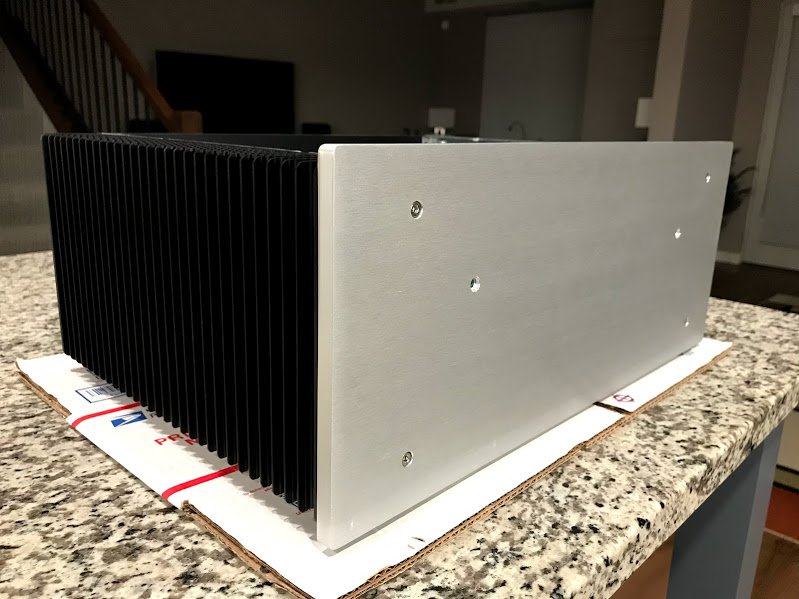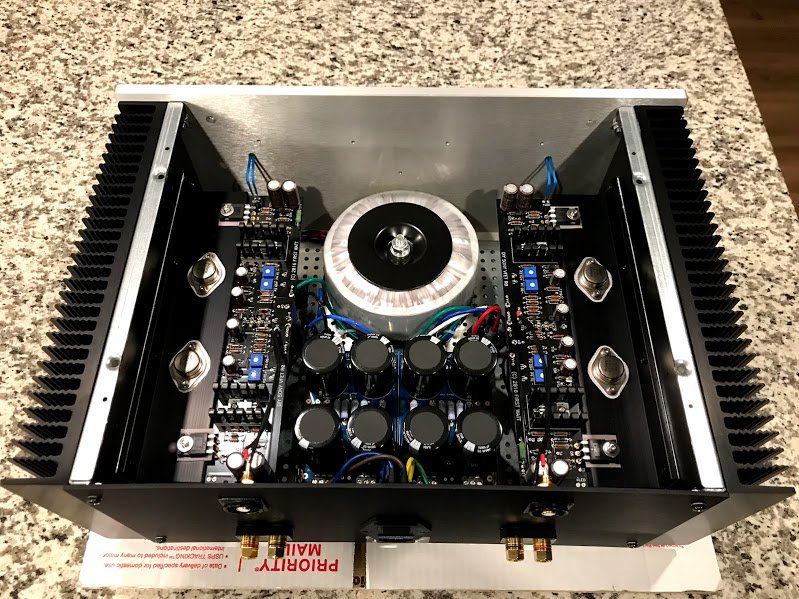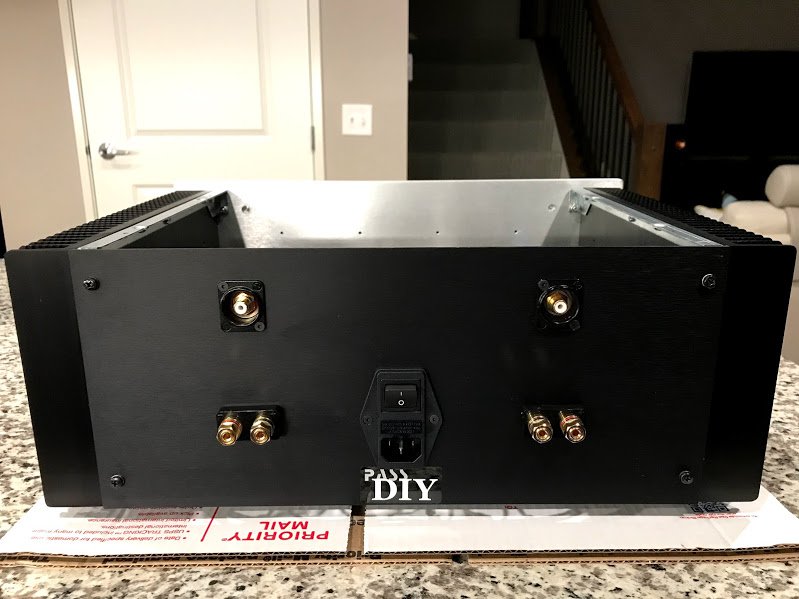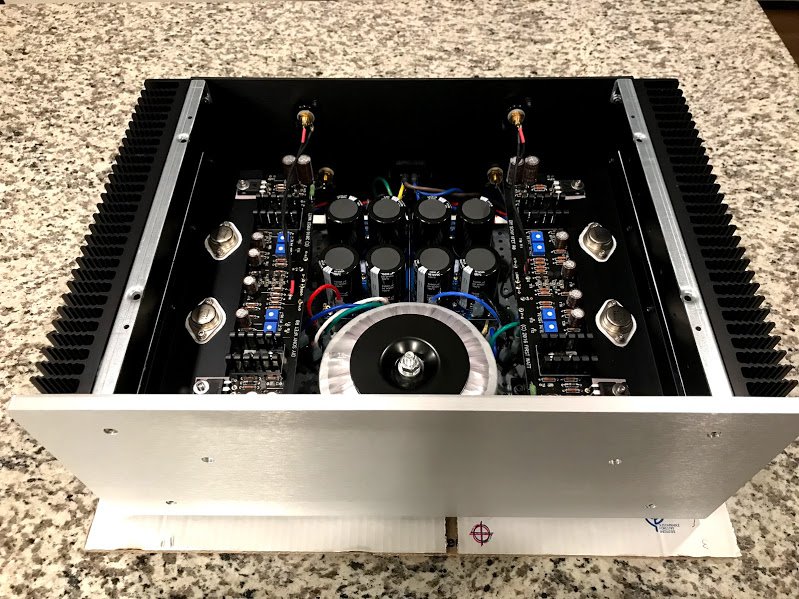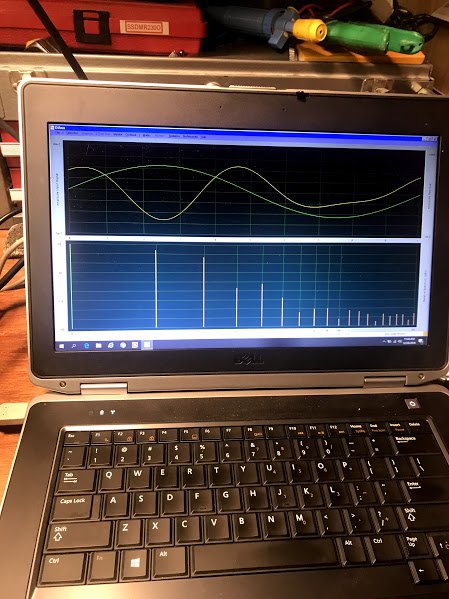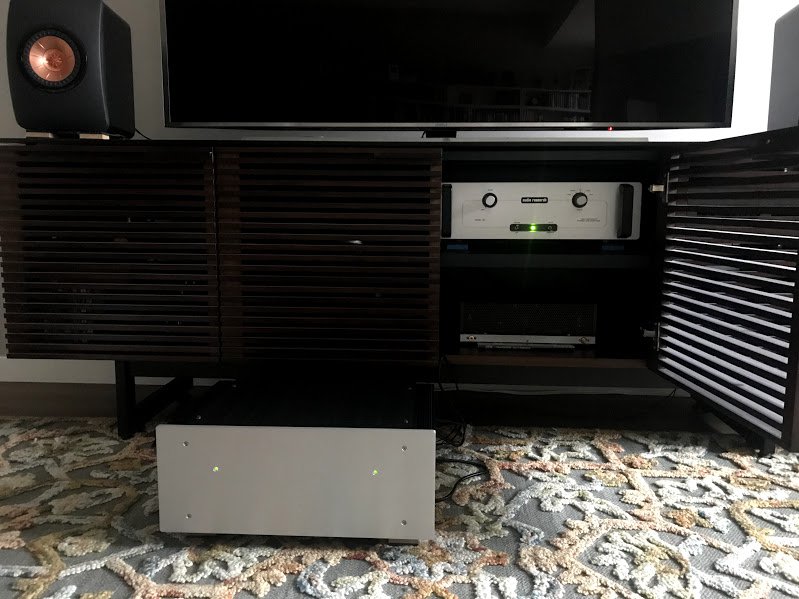-
Posts
164 -
Joined
-
Last visited
Content Type
Forums
Events
Gallery
Everything posted by rhing
-
Well I’ve finally moved to a home with a dedicated listening room and I have been able to get a lot of my equipment out of storage and hook up my Klipsch Forte II’s to the Pass DIY Sony VFET amp. Wow! I thought the Pass amp amp performed exceptionally driving the less efficient KEF LS50’s, but this combination of the Klipsch Forte II’s and Pass DIY amp is on another level. I feel like this amp was made for speakers like these. The bass is deeper with more punch and the whole package is more dynamic and lively, but still very refined with detail, tone and timbre. The soundstage is huge and deep as most people have observed with this amp. I was also able to get my rebuilt McIntosh MC240 tube P-P amp out of storage and I plan a shootout between “Papa” (what most people at diyAudio.com refer to Nelson Pass as) and “Mac Daddy” (my MC240).
-
Joe, You did a tremendous job with building both of those amps. Your dual-mono Sony VFET has to be challenging with the tight quarters of the chassis. I am curious how the Burning Amp compares to the Sony VFET amp. The reason I ask is because a good friend of mine used to own a Pass Labs Aleph 3 years ago and regretted selling it. Is the Burning Amp remotely close to the Sony VFET in terms of sound quality, and how many watts does the Burning Amp output? He owns a pair of KEF Reference 101 monitors (basically BBC LS3/5A monitors with an 8 ohm nominal impedance). Rich
-
After about 15 hours of total play time, this amplifier is starting to settle in. The bass notes are more complete with detail, depth and sustenance. The soundstage is still growing in all three dimensions, separation and space are coming into better focus, and the dynamic range has also increased with greater slam and transient response. This is a very solid amplifier and I can certainly understand why many would prefer this amp over a tube amp. In fact, it bears some resemblance to my McIntosh MC240 6L6 push-pull stereo amp with that holographic presentation, warmth and body. Even though my Forte II's are in storage, my KEF LS50's are doing a respectable job of creating room-filling sound. I can understand where many Klipsch Heritage or classic Altec horn-based speaker owners would be very pleased with an amplifier of this calibre generating 15 high quality watts into 8 ohms. I have posted on these forums about my push-pull tube amps and some really good Texas Instruments Class D amps, and this Nelson Pass designed amp is one of the best in my amplifier collection. It really has the soul of a tube amp, but it also has the desirable hallmarks of a solid state amplifier. It is an incredibly musical amplifier that allows me to get lost in the music. I really cannot rank my amps, because some are in storage or just don't work well with my KEF LS50's for a fresh comparison, but what I can say is that I will be keeping this Pas DIY amp in my system for a while.
-
Well I finally completed my Pass DIY Sony VFET amplifier project. With tremendous help from Chuck, a fellow diyAudio.com member, on the Sony VFET bias settings, I have completed my build and I am very impressed with this amp with only 6-7 hours of music playback. As I previously mentioned, I purchased a set of untested (unmatched) Sony VFETs from wdecho that he bought from Acronman a while back. He also included a pair of the T-brackets, mica insulators and a pair of the PCBs. After budgeting my money and purchasing all the parts through Mouser, Parts Connexion, the diyAudio store and the local Ace Hardware, I set off on measuring and matching resistors and capacitors and followed 6L6's excellent build guide and Nelson Pass' instructions. Chuck really helped me with biasing the Sony VFETs and then we set it up in his system to audition the amp. The DC offset was kept well close to 200mV on each channel with the final settings. Having a great local resource like him in the Twin Cities is a real blessing. It sounded like a freshly built amplifier on his very efficient horn speakers. We then tested it with his distortion analyzer to see how closely matched each channel was since the VFETs were not tested and matched by Nelson Pass. The photo shows the spectral analysis for the right channel, which looks great. To my pleasant surprise, the left channel was virtually identical to the right channel. THD on the right channel measured 0.0130% @ 1 watt, while THD on the left channel measured 0.0135% @ 1 watt. It was time to close up the chassis and take it back home to enjoy. I plugged the amp into my system consisting of an Audio Research vacuum tube phono stage, an Audio Research vacuum tube line stage and a pair of KEF LS50 monitors. This amp has no problems driving the KEF's with the gain from my ARC LS7 line stage preamp. Chuck advised me to give this amp a lot of hours for it to really settle in, but I have to say that I am already impressed. The sound is so natural and clear. This is my first Pass DIY (and solid state amp) project ever, and just following Nelson Pass' documentation, 6L6's build guide on the diyAudio.com forum, and sage wisdom from wdecho and Chuck really made this project a success.
-
This looks really compelling and I have 2 matched pairs of the Toshiba JFETs that I was considering for a Pass DIY F5 Turbo build. The most intriguing version is the single-ended Mountain View version using available Fairchild JFETs. Right now, I am building the Pass DIY Sony VFET push-pull amplifier using parts that wdecho sold to me earlier this year. I hope to complete this amp by Christmas, and I will post photos that chronicle the build process.
-
Well all I can say is that wdecho has been extremely helpful in my quest to build a Pass DIY Sony VFET Class A amplifier. He sold me a rare set of the Sony VFETs along with the First Watt printed circuit boards, Aluminum heatsink mounting brackets, and he has shared numerous DIY tips with me and many here on the Klipsch community forums. The Class D amplification thread that wdecho initiated was very informative and a great exchange of ideas on coupling new amplifier technology with vintage Klipsch Heritage speaker systems. I am not aware of what happened here, but I still correspond with wdecho on a DIY forum, and he remains generous with his knowledge and very courteous.
-
What happened to the Class D thread started by wdecho? I noticed he’s no longer a forum member either. Odd 🤔
-
Hi wdecho, Thanks for pointing out the Toshiba JFET seller on eBay. I will purchase a set tomorrow. I am confident the F5 Turbo V2 will sound very good in my system. I will take my time in acquiring all the parts and build the amp as the weather turns cold. Then I can use the amp as a space heater too.
-
Just want to let folks here know that this thread has inspired to build a Pass DIY F5 Turbo (V2) amp using PCBs and a 5U chassis from the diyAudio.com store. The 50 watts @ 8 ohms rating is really more for my KEF LS50 speakers than for my Klipsch Forte II’s, but I am sure that it will sound great with the Klipsch speakers too. Hopefully, when I finally move into a larger home and get my stuff out of storage, I can compare the F5 Turbo to my Texas Instruments TPA3255EVM Class D amp and McIntosh MC240 tune amp. I am preparing a BOM for parts and I will have to wait for the availability of the JFETs from Linear Systems.
-
I’ve read a lot of positive reviews and comments about the nCore Class D amps. I am curious how they compare to the TI TPA3255EVM Class D amps. I still have to piece together a linear power supply to run two TPA3255EVM in PBTL, but now I am thinking that I would like to build two monoblocs instead.
-

chip amps: Almost everything you ever wanted to know
rhing replied to DizRotus's topic in 2-Channel Home Audio
Hi Neil, Welcome to the TI TPA3255EVM club. At 48VDC from the power supply and assuming a nominal 8 ohm load, your amp is capable of about 140 watts power. I highly doubt you are pushing 1 watt with your efficient speakers. This amp combined with my Audio Research LS7 tube linestage preamp is great for listening for hours. -
It really depends on the output impedance of your Pono player and the input impedance of the gmarsh Weiner amplifier (based on input capacitance, gain, etc.). Can you provide this information?
-
Hi All, It's been a while since I last posted on this forum. I moved across the country for a new career opportunity and the move and changes had me out of audio for a bit since the end of 2015. Now that everything has settled in, I am back to the fun of listening to music and building and rebuilding audio gear. I have finally commissioned my gmarsh (from diyAudio.com) Weiner PBTL (i.e., mono) amps. Instead of using CineMag CMLI-15/15B input transformers to convert unbalanced to balanced inputs to feed the Weiner's TPA3118 amplifier chips' differential inputs, I chose to use vintage Altec/Peerless 15335A bridging transformers with the same specifications as the CineMag CMLI-15/15B transformers. I've also been trying different settings with the adjustable amplifiers and I've currently set the switching frequency to 1.2MHz in BD mode with a gain of 20dB. The gmarsh-designed Weiner BTL (stereo) and PBTL (mono) TPA3118 Class D amps are very well designed and built with quality components. Even though I can work with small SMD components, I purchased semi-completed amp modules to save time. I have both versions, and I have to say the the PBTL amps with the Altec/Peerless 15335A input transformers sound incredibly good. Since I have not had the time to swap input transformers, I cannot clearly attribute the improvements over the Weiner stereo amp to the transformers, but I am using the same modified Astron RS-12A linear regulated power supply for both. To my ears, the Weiner PBTL dual mono amps provide better driver control of my Crites-upgraded Forte IIs giving me better separation, extended and better defined bass response, greater midrange presence and a smoother treble. The improvements are not readily obvious, but I can hear them and the dual mono amp just seems to offer a warmer, more musically engaging presentation. gmarsh's Weiner Class D amps are only offered through limited group buys at diyAudio.com. Even though these amps cost more than the Chinese manufactured TPA3116 and TPA3118 amps sold online, these amps are tested and represent the "best in class" in terms of build quality and circuit design. One doesn't have to replace components to improve the performance, because the best components are already used. I am in the process of renewing a McIntosh MC240 tube amp and I expect to have the power supply components updated this coming weekend. To compare the Weiner Class D amps to the likes of an MC240 tube amp driving Klipsch Heritage speakers seems a bit one-sided, but it really isn't. These Class D amps may not best the MC240, but they are not that far behind. I should mention that my system is comprised of an Audio Research PH5 phono stage and Audio Research LS7 line stage. These tube preamps really work well with any amplifiers in my collection.
-

chip amps: Almost everything you ever wanted to know
rhing replied to DizRotus's topic in 2-Channel Home Audio
That is correct. You might need to adjust the impedance at the inputs depending on the output impedance of the Pono player. The TI data sheet for the TPA311x amp IC describes the relationship between the input capacitance, gain and input impedance of the amp. If the Pono player is your sole source, this should be an ideal connection for a balanced source with a balanced amp. -

chip amps: Almost everything you ever wanted to know
rhing replied to DizRotus's topic in 2-Channel Home Audio
Sorry I haven't chimed in here. I moved from the West Coast to the East Coast for a great career opportunity, and we finally moved into our new home last month. I now have my new listening room set up and I am still using my Weiner TPA3118 Class D stereo amp with the rest of my system. My latest toy is a mint condition stock McIntosh MC240 6L6 push-pull amp. This is an amp I've wanted for many years and I finally got one. Anyway, I am still a proponent of using 1:1 input transformers for converting unbalanced, single-ended RCA inputs to the differential (i.e., balanced) inputs of the TPA3118 amp for the same benefits I mentioned before. With a larger listening room, I can really appreciate just how good this amp works with my Crites-upgraded Forte II's. With my ARC LS7 line stage, the sound is warm, rich and detailed. My preference, of course, is to use my McIntosh tube power amp, but every time I switch back to the Weiner TPA3118, I am really impressed how great it sounds. It doesn't sound like a typical Class D amp with a hyped up treble, but instead presents a very musical reproduction of my vinyl and CD collection. In the last Weiner group buy on DIY audio, I picked up a pair of gmarsh's Weiner 2 PBTL amps. I still have to build them, but these boards can accommodate the rather largish CoilCraft output inductors. I plan to use input transformers with these amps and possibly some film and oil caps for a velvety-smooth sound. I'm sure someone reading this post might think I like a syrupy, lush tube sound. I just like music to sound real, and great sound is not dry, edgy, grainy or distorted, but very organic with presence. I was listening to King Crimson's "20th Century Schizoid Man" on vinyl earlier today, and the Weiner amp did such a great job reproducing Fripp's chords with the horns blasting. I've said this before, and I will say this again. With these highly efficient Class D amps, the quality of the power supply is everything. I modified an Astron RS-12A regulated linear power supply I bought locally in California through Craigslist for $20. Using a cheap wall wart switching supply will only go so far, but for these TPA3116 or TPA3118 amps to really sing, get a nice high-current, regulated power supply with some adequate reserves for transient response. Additionally, use some good, efficient speakers like Klipsch Heritage series speakers or some classic Altec Lansing horns that have excellent midrange response. -

chip amps: Almost everything you ever wanted to know
rhing replied to DizRotus's topic in 2-Channel Home Audio
I still love my tube amps. I have a project to restore and modify a Magnavox 6BQ5/EL84 single ended pentode tube amp. These little gems sound great through Klipsch speakers. I just scored on a factory matched quartet of JJ EL84 tubes at Apex Jr. (http://www.apexjr.com) in Torrance, CA for $32 dollars. I was down in Southern California for my niece's wedding, and had to stop by Apex Jr. to pick up on some DIY goodies like wire, connectors, caps and tubes. If I had more time, I would have driven up to L.A. to visit Amoeba's and all the other great vinyl stores around Melrose. The great thing about the TDA7297 amp is that I can use this as an integrated on warm weather days. It works well with my PH5 phono stage and my Sony ES player. With this amp being over 80 percent efficient, the power supply is everything in getting the most out of these chip amps. My Astron RS-12A is rated to put out 9A continuous current. Astron has been known to inflate their specifications; the regulated linear power supply is probably putting out around 6-7A continuously. Still, this is plenty of current to drive this chip amp with plenty of headroom. I purchased my Astron via Craigslist for $20 in San Jose, and replaced the electrolytic filter caps with a big 22,000uF Rifa PEH-200 cap, a Nichicon KZ Muse cap and a Panasonic FM cap. Even though the PSU was in physical mint condition, the caps looked like aging 1970's vintage Elna's. The cap replacement made a significant improvement in sound quality. -

chip amps: Almost everything you ever wanted to know
rhing replied to DizRotus's topic in 2-Channel Home Audio
It's been a while since I've posted here. I've been experimenting with the Texas Instruments TPA3116 and TPA3118 Class D amplifiers and ST Micro TDA7297 Class AB amplifiers, and a few hundred dollars of parts and amplifier modules, I've come to the conclusion that the TDA7297 is a worthy chip amp champ in terms of sound quality, energy efficiency and value. This little amp driven with my modified Astron RS-12A regulated linear power supply (14VDC) can generate as much as 8 watts within reasonable distortion levels. This is plenty of power to drive most efficient Klipsch speakers. I can drive my Forte II's to ear-splitting levels with plenty of headroom with this amp. As discussed earlier in this thread, there are many possibilities for powering these miniature amps. I've found that my Astron regulated linear power supply provides clean power (i.e., voltage and current) that allows this amp to create a huge soundstage (deep, wide and tall), articulate bass, warm mids and extended highs an a focused image with excellent separation between performers. As a reference, my system consists of the following: Restored and modified Kenwood Trio PC-400U belt-idler wheel drive turntable (a la Thorens TD-124) Talisman Alchemist IIB high output MC cartridge re-tipped by Needle Clinic Sony ES DVP-NS999ES DVD/SACD/CD player Audio Research PH5 JFET/6922 tube phono stage preamplifier Audio Research LS7 tube line stage preamplifier Restored Dynakit Stereo 35 6BQ5/EL84 push-pull tube amplifier modified with Enhanced Fixed Bias (EFB) Klipsch Forte II speakers modified with Bob Crites Titanium tweeter diaphragms, capacitor replacement and internal wiring kit, and Pomona 3770 Copper binding posts Recently, I modified a TDA7297 amplifier module purchased from eBay seller "homemart.usa." This amp cost under $7 with shipping from China. Delivery to the US takes about 7-10 days. The stock unit actually sounds pretty good, but significant improvements can be realized with a minimal investment of money and DIY time. Removed yellow 100nF ceramic cap Replaced the polarity protection diode with a sold core Copper wire Replaced the stock 2,200uF/25V electrolytic cap with a 470uF/35V Nichicon KZ Muse electrolytic cap for the power supply/DC decoupling cap Replaced the two (2) stock .22uF Mylar film caps with 1.0uF/250V Radio Shack Mylar film caps (http://www.radioshack.com/1-0uf-250v-10-metal-film-capacitor/2721055.html#.VTplAWd0zDc) Replaced the three (3) stock terminal blocks with Weidmuller terminal blocks Replaced stock 50k volume pot with 50k 21-step SMD resistor stepped attenuator, and used Mundorf Silver-Gold wire as hook-up wire I installed this in a Context Engineering split-body Aluminum enclosure that had a previous TDA7297 build in it. To my ears, this amp sounds really good. It may not have the full tube bloom of my Dynakit tube amp, but it has a warmth and presence that could easily fool someone into thinking they are listening to a tube amplifier. Better yet, this amp is 80+ percent efficient, so it would make an excellent warm weather amplifier. Probably the most significant modification is increasing the input capacitance from .22uF to 1.0uF per each channel. This lowers the high pass input filter corner frequency to below 20Hz, so that the bass response and definition are significantly improved. The Radio Shack film caps are some of the best kept secrets in DIY audio. Unfortunately, these caps are only available in 1.0uF/250V. -
I just bought two matched pairs of Genelex Gold Lion ECC88/6922 reissues from Jim McShane for my Audio Research PH5 phono stage. Jim tests and burns in the Gold Lion reissue tubes he sells. Anyway, I couldn;t be happier with my purchase. These aren't inexpensive, but Jim stands behind what he tests and sells, and I've only had great service and reliable tubes from him. I have had no problems with microphony or noise from the Gold Lion reissues. For my Audio Research LS7 line stage, I recently purchased two matched pairs of tested JJ E88CC/6922 tubes. This is what I have in my LS7 now, and I really like the warm midrange and sweet highs. My new set of JJ's is coming from the Tube Depot, since Jim McShane does not carry them anymore. I'm sure that there are great NOS and OS 6922's out there as many have recommended. I usually get the best new production tubes I can get from reputable dealers.
-

chip amps: Almost everything you ever wanted to know
rhing replied to DizRotus's topic in 2-Channel Home Audio
It's happened to all of us. Live and learn. -

chip amps: Almost everything you ever wanted to know
rhing replied to DizRotus's topic in 2-Channel Home Audio
The cap installed incorrectly is probably the root cause if the failure. What is your power supply? You want to make sure you connect that properly in terms of polarity too. -

chip amps: Almost everything you ever wanted to know
rhing replied to DizRotus's topic in 2-Channel Home Audio
Not sure you'll get much of a response on the 2-channel forum. I would think you'd want more power for home theater applications. -

chip amps: Almost everything you ever wanted to know
rhing replied to DizRotus's topic in 2-Channel Home Audio
The Switchcraft 722A 2.1mm x 5.5mm DC power connector is located just below the power switch. From the connector, I run the "+" wire up to one lead of the NKK SPST power switch. Another wire is soldered to the other power switch terminal and twisted with the black Ground (or 0V DC) wire from the DC power connector and fed to the amp board where I have an additional Panasonic FM 2200uF / 25V cap soldered at the power input thru-holes--J8 in this instance. I'm using the same modified Power One MAP110-S148 SMPS I have used for my T-amps and TDA-7297 amp. I had replaced all the second stage filter caps with 7X Panasonic FM 2200uF / 25V electrolytic caps and fabricated a DC power cable: 2X Kimber Kable TCSS 19AWG wires twisted as a pair Polyethylene spiral cut tubing slid over the twisted pair Polyester expandable sledging slid over the spiral cut tubing Switchcraft DC power connectors added This SMPS voltage output can be adjusted between 11 and 13.4V DC. I just have it set to 12V DC right now. This beats any of those brick supplies that came with my T-amps. I would like to build a nice, quiet high current regulated linear power supply, but that's a project that is beyond my DIY skills. I'm considering an Astron RS-12A regulated linear power supply, which is used for CB radios. Handmade Electronics sells the Kimber Kable TCSS for just over $1.00/ft. I use this wire to connect the amp to the speaker binding posts as well. If you know how to make a tri-braid, you can even make your own Kimber Kable PBJ interconnects with the TCSS wire (2X - Ground, 1X - Signal), one of the best interconnects for the money. -

chip amps: Almost everything you ever wanted to know
rhing replied to DizRotus's topic in 2-Channel Home Audio
Sorry to hear about your Sure TA2024 amp. Here are some photos of my completed Sure Electronics TPA3110D2 Class D amp. I ended up with another Panasonic FC 1800uF / 25V electrolytic cap on the power supply inputs on the board. This improved the sound in terms of deeper, tighter bass, a larger, deeper soundstage and a warmer sound. The chassis is just about 3/4" wider than my iPhone 5 and the same length. Since it has slots to accommodate 3" wide boards like the Sure amp, I didn't even need to use stand-offs to mount it. I really like the sound of this amp a lot. I used my Alan Parsons' "Sound Check 2" test CD to measure the frequency response from my Klipsch Forte IIs to compare the TPA3110D2 and TDA7297. The TPA3110D2 goes down to 31.5Hz, while the TDA7297 rolls off at around 40Hz. -

chip amps: Almost everything you ever wanted to know
rhing replied to DizRotus's topic in 2-Channel Home Audio
I've been experimenting with the Sure Electronics TPA31110D2 Class D amp module I bought from Parts Express for $10. Here's what I've done to date: Removed both stock 220uF / 25V power supply capacitors and replaced them with two (2) Panasonic FM 1,500uF / 25V low ESR electrolytic capacitors. Moved the Vampire CM1F RCA connectors closer to the amplifier signal inputs at the front of the board to shorten the signal path. Installed a Panasonic EVJ 50kohm audio taper dual gang volume potentiometer between the RCA connectors for volume control to use as a standalone amplifier. Using this as a power amp with my Audio Research LS7 tube line stage preamp, or as an integrated amp, this is a very transparent amp. I can hear things that I do not normally hear with my modified TDA7297 chip amp or my SMSL SA-S1 T-amp. With the upgraded power supply caps, the sound quality improved in terms of: Bass response Richer tonality Greater dynamic range-headroom Reduced noise Greater separation of performers I still hear a little background noise when I use this amp with the LS7 as a power amp, but when used alone, it is dead quiet like the TDA7297 chip amp. Even though this amp is rated around 5-8 watts with distortion less than 0.1-0.5%, it can easily drive my Klipsch Forte IIs. I've listened to a variety of music including rock, classical and jazz. I could see where the Texas Instruments Class D amp would make a great studio monitor amp for its accuracy. The tonality is very good and the amp has some warmth. I really see no other need for additional modifications at this point. -

chip amps: Almost everything you ever wanted to know
rhing replied to DizRotus's topic in 2-Channel Home Audio
Very good question. I have no reference for how the Denon 4520 performs, but being a Denon product I am sure it sounds good. Right now, the only commercially available amplifier using the Texas Instruments TPA31xx series Class D amplifiers is the TBI Millenia: http://www.tbisound.com/dsp_products_millenia.asp You can read the reviews linked to their Web site. These amps all have the similar Texas Instruments house sound, which based on my experience thus far, is very impressive. Here are a couple links to the diyAudio.com forum threads discussing these amps: http://www.diyaudio.com/forums/class-d/217903-ti-tpa3100d2-amazing-class-d-amp.html http://www.diyaudio.com/forums/class-d/237086-tpa3116d2-amp.html These amps are reasonably priced, so conducting your own experiment is pretty easy as long as you know how to stick wires into screw-down terminal blocks. As I mentioned earlier, the Yuan Jing amps available on eBay are probably the best choice for most. It offers higher power and it can be used with longer speaker cable lengths than the Sure Electronics TPA3110D2 amp. I've been listening to some really well recorded RCA Living Stereo SACDs of orchestral music, and it really is impressive how this little amp seems to have incredible drive and headroom for reproducing complex passages. To my ears, I feel like I have a KT88 push-pull tube amp connected to my Audio Research LS7 Tube line stage preamp. With the higher efficiency of the La Scalas, an amp like this would play louder.




